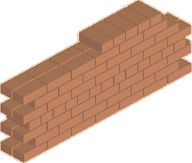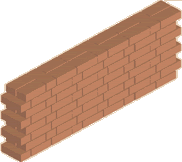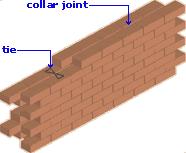|
|  |
Stretcher Bond is the easiest bond to lay and minimises the amount
of cutting required. It can be used for single skin walls quite easily.
When used as a double skin wall, the two skins are locked together
across the collar joint by means of wall ties.
Header bond is not used as often as stretcher bond, but is
equally simple. It's impractical for single skin walls, but is
popular for diaper work, where patterns, usually diamonds
or criss-crosses are picked out in bricks of different colours.
|
|
| |
English Bond is a traditional bond dating back hundreds
of years and features alternating courses of stretchers
and headers. This is one of the strongest brickwork bond
patterns. |
|

|
English Garden Wall Bond is a simple variation of English
bond, where the header courses are separated either 3 or
4 courses of stretchers. There is also a 'Scottish Bond'
featuring 5 courses of stretchers between courses of headers.
|
|
Monk Bond can be thought of as an intermediate between Flemish Bond
and Flemish Garden Wall Bond. In this pattern, the header bricks are
separated by 2 stretchers. The headers of even numbered courses straddle
the joint between the two stretchers of the underlying odd-numbered course.

Flemish Garden Wall Bond increases the ratio of stretchers to headers in
each course from 1:1 to 3:1. The header bricks are separated by 3
stretchers. The headers of even numbered courses are set to the centre
on the middle stretchers of the underlying odd-numbered course.
|
|

